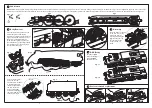
3
Lubrication
1
Fig. 11
Fig. 12
Fig.1
IMPORTANT – Only apply small single drops of light machine oil to the places indicated in red in Fig.2 and Fig.3. This is best achieved by making a simple oil ‘dropper’ as illustrated in Fig.1. Insert a straightened paper clip into a cork and use
a bottle cap as a container for the oil. A small drop of oil can then be picked up by the dropper and applied in exactly the right place. Immediately wipe off any excess oil, especially from the locomotive body. Only lubricate moving parts.
DCC Ready
4
Location of DCC
Ready socket (Fig.11)
and Sound/DCC
Decoder (Fig.12)
Turn the tender upside
down, remove the
assembly screw as shown
in Fig.8. Carefully turn
tender the right way up
and ease the chassis
down, gently pulling
backward to disengage
the chassis from the front
of the tender (Fig.9).
Fig. 2
Fig. 3
Fig. 5
Fig. 8
Fig. 9
Body Removal
2
Turn the locomotive upside down and
detach the speedo assembly and
lubricator. See Figs 4 and 5. Remove the
bogie assembly and assembly screw as
shown in Fig.6. Carefully turn the
locomotive the right way up and ease
the chassis down, gently pulling forward
to disengage the rear chassis lug from
the rear of the body. Fig.7
Fig. 6
Fig. 7
Fig. 4
OR
Once the tender is coupled
to the loco, connect the
locomotive wires by
carefully push fitting the
plug into the socket on
the underside of the
tender as shown in
Fig.10.
Assembly
3
Fig. 10
2
Coal removal and replacement
5




















